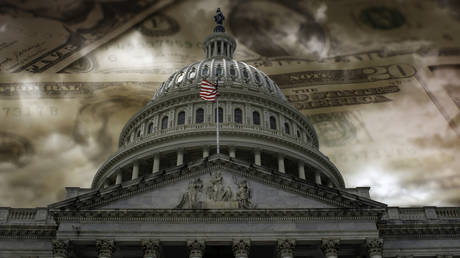
US debt to top $54 trillion – budget office
An aging population and higher interest expenses have been pushing the country’s indebtedness higher
The US national debt could surge by $19 trillion over the next decade to surpass the $54 trillion mark, owing to the mounting costs of an aging population and higher interest expenses, according to the latest report by the Congressional Budget Office (CBO). The debt exceeded $34 trillion in December.
A key factor that will likely lead to a further surge in the national debt is the sharp increase in the federal deficit, according to the CBO, which projects the annual shortfall rising to $2.6 trillion in 2034, up from $1.6 trillion this year, adding $18.9 trillion to the national debt during the decade.
The CBO’s director, Phillip Swagel, told reporters last week that the US remained on track to rack up more debt as a share of its total economic output in 2034 than at any other time in its history. “The first message of the projections is a familiar one: that the fiscal trajectory is daunting. On the other hand, it is a little bit less bad than it was in our projections last year,” Swagel said, as quoted by the New York Times.
The budget office’s projections come as Congress faces another deadline next month to agree on federal spending legislation. Lawmakers have been in a heated debate lately over providing more aid to Ukraine and Israel.
Meanwhile, interest rates in the US skyrocketed to two-decade highs over the past year, making borrowing costs a significant contributor to the national debt. According to the CBO, the US will spend more than $12 trillion alone on interest costs from 2024 to 2034. The budget office warned that starting next year net interest costs will be larger as a share of the US economy than at any time since the federal government started keeping records in 1940.
READ MORE: US will run out of paper to print dollars – Kremlin
“Also boosting deficits are two underlying trends: the aging of the population and growth in federal health care costs per beneficiary,” Swagel stated. “Those trends put upward pressure on mandatory spending.”
The US exceeded its debt ceiling, which was legally set at $31.4 trillion, in January 2023. After months of warnings of an imminent and economically disastrous default from the US Treasury, President Joe Biden in June signed a bipartisan debt bill that suspended the cap until January 2025. This effectively allowed the government to keep borrowing without limits through next year. Debt spiked to $32 trillion less than two weeks after the bill was approved, and has been piling up ever since.
For more stories on economy & finance visit RT’s business section


